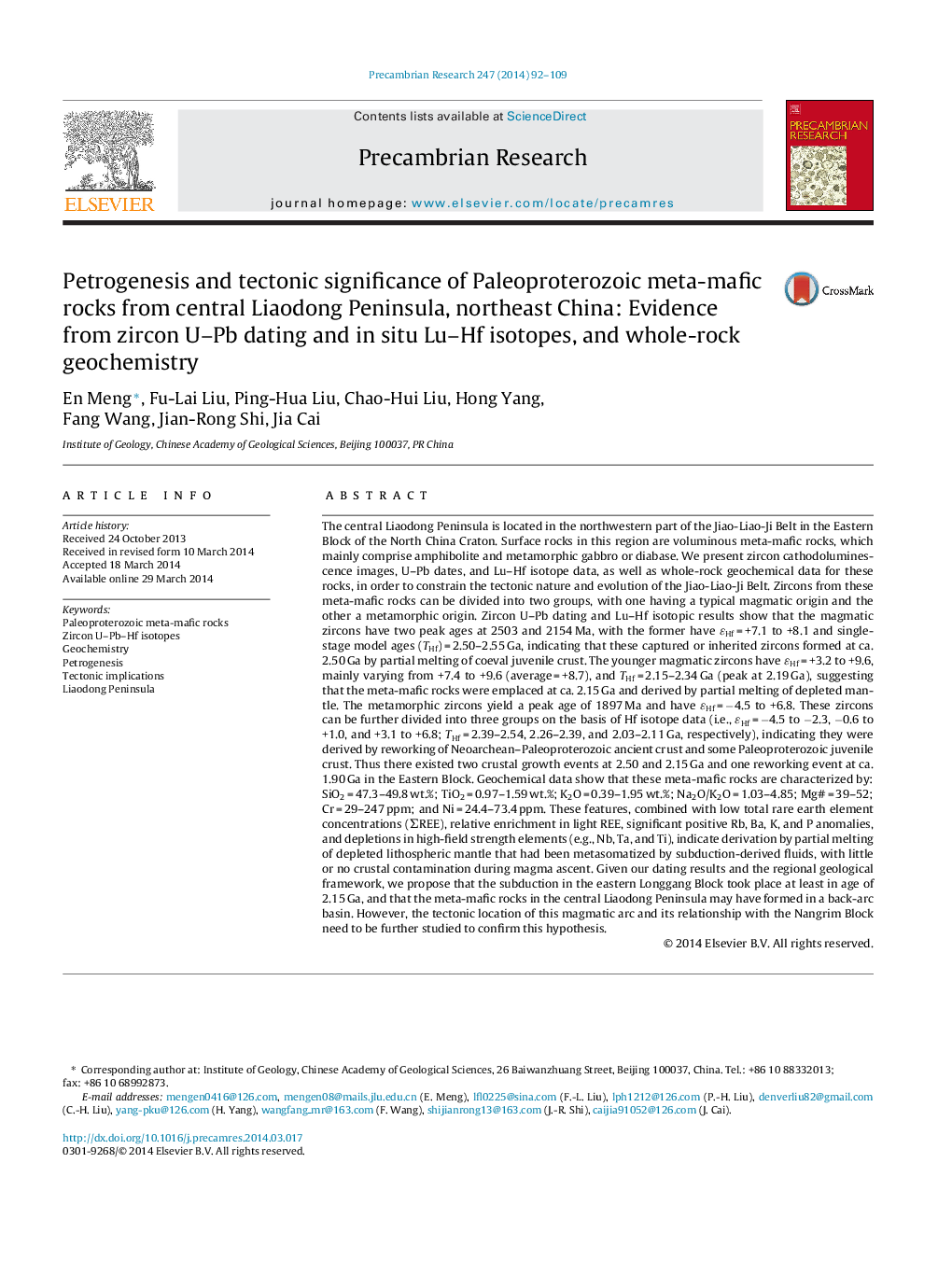| Article ID | Journal | Published Year | Pages | File Type |
|---|---|---|---|---|
| 4723094 | Precambrian Research | 2014 | 18 Pages |
•Meta-mafic rocks in the central Liaodong Peninsula was emplaced at 2154 Ma, and metamorphosed at 1897 Ma.•These rocks were derived from a depleted mantle source with extremely minimal crustal contamination.•These rocks formed in a back-arc basin.
The central Liaodong Peninsula is located in the northwestern part of the Jiao-Liao-Ji Belt in the Eastern Block of the North China Craton. Surface rocks in this region are voluminous meta-mafic rocks, which mainly comprise amphibolite and metamorphic gabbro or diabase. We present zircon cathodoluminescence images, U–Pb dates, and Lu–Hf isotope data, as well as whole-rock geochemical data for these rocks, in order to constrain the tectonic nature and evolution of the Jiao-Liao-Ji Belt. Zircons from these meta-mafic rocks can be divided into two groups, with one having a typical magmatic origin and the other a metamorphic origin. Zircon U–Pb dating and Lu–Hf isotopic results show that the magmatic zircons have two peak ages at 2503 and 2154 Ma, with the former have ɛHf = +7.1 to +8.1 and single-stage model ages (THf) = 2.50–2.55 Ga, indicating that these captured or inherited zircons formed at ca. 2.50 Ga by partial melting of coeval juvenile crust. The younger magmatic zircons have ɛHf = +3.2 to +9.6, mainly varying from +7.4 to +9.6 (average = +8.7), and THf = 2.15–2.34 Ga (peak at 2.19 Ga), suggesting that the meta-mafic rocks were emplaced at ca. 2.15 Ga and derived by partial melting of depleted mantle. The metamorphic zircons yield a peak age of 1897 Ma and have ɛHf = −4.5 to +6.8. These zircons can be further divided into three groups on the basis of Hf isotope data (i.e., ɛHf = −4.5 to −2.3, −0.6 to +1.0, and +3.1 to +6.8; THf = 2.39–2.54, 2.26–2.39, and 2.03–2.11 Ga, respectively), indicating they were derived by reworking of Neoarchean–Paleoproterozoic ancient crust and some Paleoproterozoic juvenile crust. Thus there existed two crustal growth events at 2.50 and 2.15 Ga and one reworking event at ca. 1.90 Ga in the Eastern Block. Geochemical data show that these meta-mafic rocks are characterized by: SiO2 = 47.3–49.8 wt.%; TiO2 = 0.97–1.59 wt.%; K2O = 0.39–1.95 wt.%; Na2O/K2O = 1.03–4.85; Mg# = 39–52; Cr = 29–247 ppm; and Ni = 24.4–73.4 ppm. These features, combined with low total rare earth element concentrations (ΣREE), relative enrichment in light REE, significant positive Rb, Ba, K, and P anomalies, and depletions in high-field strength elements (e.g., Nb, Ta, and Ti), indicate derivation by partial melting of depleted lithospheric mantle that had been metasomatized by subduction-derived fluids, with little or no crustal contamination during magma ascent. Given our dating results and the regional geological framework, we propose that the subduction in the eastern Longgang Block took place at least in age of 2.15 Ga, and that the meta-mafic rocks in the central Liaodong Peninsula may have formed in a back-arc basin. However, the tectonic location of this magmatic arc and its relationship with the Nangrim Block need to be further studied to confirm this hypothesis.
Graphical abstractFigure optionsDownload full-size imageDownload as PowerPoint slide
